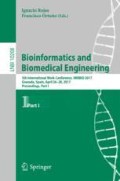Abstract
The aim of this work was to develop activated carbon (AC) from date pit powder and evaluate its adsorption efficiency of bilirubin toxin. In order to increase the adsorption capacity of bilirubin, an increase in the surface area is necessary. This increase was achieved through pyrolysis technique and to further increase the absorption capacity of AC when coated with chitosan gel, which contains several groups on its chains that act as interaction sites. Results indicated that the presence of the AC lead to a decrease in bilirubin content and the more the AC added to the sample, the faster the rate of adsorption as well as the higher the capacity of adsorption. A 0.3 M AC concentration shows a 0.82 left over bilirubin fraction after 16 h, while a 0.1 M AC concentration shows a 0.9 bilirubin fraction after the same interval of time. Contact time is another factor that also contributed to the increase in adsorption of bilirubin. It was seen that chitosan coated AC shows an increase in adsorption percentage from about 25% to 96% when left for a longer period of time.
Access this chapter
Tax calculation will be finalised at checkout
Purchases are for personal use only
References
Pless, G.: Artificial and bioartificial liver support. Organogenesis 3(1), 20–24 (2007)
Annesini, M.C., Piemonte, V., Turchetti, L.: Simultaneous removal of albumin-bound toxins in liver support devices: bilirubin and tryptophan adsorption on activated carbon. Chem. Eng. Trans. 32, 1069–1074 (2013). doi:10.3303/CET1332179
Magosso, E., Mauro, U., Luigi, C., Olga, B., Luigi, B., Sergio, S.: A modeling study of bilirubin kinetics during molecular adsorbent recirculating system sessions. Int. Cent. Artif. Organs and Transplant. 30(4), 285–300 (2006)
Puri, P., Anand, A.C.: Liver support devices. Med. Update 22, 489–493 (2012)
Andrade, J.D., Kopp, K., Van Wagenen, R., Chen, C., Kolff, W.J.: Activated Carbon and Blood Perfusion: A Critical Review, Vol 9, No.25 (n.d.), pp. 290–302
Mahmoudi, K., Noureddine, H., Ezzeddine, S.: Preparation and characterization of activated carbon from date pits by chemical activation with zinc chloride for methyl orange adsorption. J. Mater. Environ. Sci. 5(6), 758–769 (2014)
Hussain, M.Z., Mostafa, I.W., Vandita, S., Venitia, S., Mohammad, S.R.: Chemical composition of date-pits and its potential for developing value-added product – a review. Pol. J. Food Nutr. Sci. 64(4), 215–226 (2014)
Luk, C.J., Joanne, Y., Chunwah, M.Y., Chiwai, K., Kimhung, L.: A comprehensive study on adsorption behaviour of direct, reactive and acid dyes on crosslinked and non-crosslinked Chitosan Beads. J. Fiber Bioeng. Inf. 7(1), 35–52 (2014)
Kyzas, G.Z., Dimitrios, N.B.: Recent modifications of chitosan for adsorption applications: a critical and systematic review. Marine Drugs 13, 312–337 (2015)
Moussaoui, Y., Mnasri, N., Ben Salem, R., Lagerge, S., De Menorval, L.C.: Preparation of Chitosan Gel, EDP Sciences, pp. 1–8 (2012)
Soundarrajan, M., Gomathi, T., Sudha, P.N.: Understanding the adsorption efficiency of chitosan coated carbon on heavy metal removal. Int. J. Sci. Res. Publ. 3(1), 1–10 (2013)
Khaled, M., Noureddine, H., Ezzeddine, S.: Preparation and characterization of activated carbon from date pits by chemical activation with zinc chloride for methyl orange adsorption. J. Mater. Environ. Sci. 5(6), 1758–1769 (2014)
Mirzayant, Y.W.: Experimental study on the use of chitosan coated activated carbon to reduce the content of metal Fe the produced water. ARPN J. Eng. Appl. Sci. 10(22), 10506–10510 (2015)
Kumar, P.S., Kirthika, K.: Equilibrium and kinetic study of adsorption of nickel from aqueous solution onto Bael tree leaf powder. J. Eng. Sci. Technol. 4(4), 351–363 (2009)
Desta, M.B.: Batch sorption experiments: langmuir and freundlich isotherm studies for the adsorption of textile metal ions onto teff straw (eragrostis tef) agricultural waste. J. Thermodyn. 20(13), 6 (2013). Article ID 375830
Neuvonen, P.J., Olkkola, K.T.: Oral activated charcoal in the treatment of intoxications. Med. Toxicol. Adverse Drug Experience 3(1), 33–58 (1988)
Putra, E., Pranowo, R., Sanarso, J., Indraswati, N., Ismadji, S.: Performance of activated carbon and bentonite for adsorption of amoxicillin from wastewater: Mechanisms, isotherms and kinetics. J. Int. Water Assoc. 43(9), 2419–2430 (2009)
Annesini, M., Carlo, C., Piemonte, V., Turchetti, L.: Bilirubin and tryptophan adsorption in albumin-containing solutions I: equilibrium isotherms on activated carbon. Biochem. Eng. J. 40(2), 205–210 (2008)
Ash, S., Sullivan, T., Carr, D.: Sorbent suspension vs. sorbent columns for extracorporeal detoxification in hepatic failure. Ther Apher Sia 10(2), 145–153 (2006)
Nikolaev, V., Sarnatskaya, V., Sigal, V., Klevtsov, V., Makhorin, K., Yushko, L.: High-porosity activated carbon for bilirubin removal. Int. J. Artif. Organs 14(3), 179–185 (1991)
Chandy, T., Sharma, C.: Polylysine-Immobilized Chitosan Beads as adsorbents for bilirubin. Int. J. Artif. Organs 16(6), 568–576 (1992)
Acknowledgement
The authors would like to thank UAEU for their support of the project. This work has been financially funded by the SURE program at UAE University, Al Ain.
Author information
Authors and Affiliations
Corresponding author
Editor information
Editors and Affiliations
Rights and permissions
Copyright information
© 2017 Springer International Publishing AG
About this paper
Cite this paper
Mwafy, A. et al. (2017). Adsorption of Bilirubin Toxin in Liver by Chitosan Coated Activated Carbon Prepared from Date Pits. In: Rojas, I., Ortuño, F. (eds) Bioinformatics and Biomedical Engineering. IWBBIO 2017. Lecture Notes in Computer Science(), vol 10208. Springer, Cham. https://doi.org/10.1007/978-3-319-56148-6_21
Download citation
DOI: https://doi.org/10.1007/978-3-319-56148-6_21
Published:
Publisher Name: Springer, Cham
Print ISBN: 978-3-319-56147-9
Online ISBN: 978-3-319-56148-6
eBook Packages: Computer ScienceComputer Science (R0)

